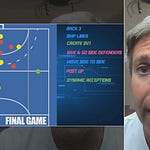The progression and success of a field hockey team are inextricably linked to its defensive structure. While attacking hockey inevitably excites fans and rewards with goals, it is defensive discipline, system clarity, and collective understanding that often underpin championship-winning sides.
Choosing and Adapting Defensive Systems
Key Points to Consider Before Selecting a System
Fede opened the session by highlighting the complexity and context-specific nature of defensive choices. There is no universal solution—rather, systems must reflect a team's philosophical "DNA," player characteristics, and the qualities of the opposition. The process begins with the team’s overarching denial or defensive philosophy. Coaches must evaluate whether the opposition favours vertical build-up or lateral play, relies heavily on aerials or technical manipulation, or has clear target players whose influence needs to be minimized.
Additionally, understanding the technical and tactical attributes of both your own defenders and the opposition is crucial. This involves analysing passing range (flicks, long hits, short passes) and tactical discipline. Training sessions should progress methodically: unopposed to opposed, video analysis for correction and communication, and eventual integration in friendly matches to assess the robustness of the system under match intensity.
A key warning from Fede: avoid the “copy-paste” temptation. Systems need to fit the players’ qualities and align with the club’s philosophical identity. Blindly replicating what works for another team ignores the nuance of context and squad composition.
Exploring Two Core Defensive Systems: Diamond (V-Press) & Hook Press
The Diamond or "V-Press" System
The first major system Fede dissected was the V-Press, renowned for its diamond defensive structure. Its essence lies in protecting the center, channeling opposition play from the inside to the outside lanes, and maintaining diagonal pressing lines. The libero (or "libero") is a pivotal figure, tasked with covering the hotline and managing defensive overloads.
Structurally, the V-Press operates with three strikers, three midfielders, and three defenders, forming a diamond at the back. When the ball moves to the flank, support-side defenders and midfielders shift across, compressing play and shrinking recoverable space. With good execution, this system routinely creates 3v1 situations in pressing zones, promoting turnovers and sparking counter-attacks.
The V-Press is dynamic. The positioning of strikers can be manipulated—either to entice play through the center (recovering in the middle) or to force the opposition to the sideline (recovering in "red zones"). For the system to function optimally, diagonal pressure from high midfielders is vital, preventing vertical passes and dominating central space.
Variants such as “cut presses” allow for sudden trap triggers, deploying the central or side strikers to cut off passing lanes as the ball is played. Adding layers of sophistication, coaches can have their side and central strikers play narrower or wider depending on the desired zone of recovery. This adaptability ensures the V-Press isn't rigid but can be molded to suit opposition build-up structures and game context.
Another notable variant is the "sonal mix": strikers and midfielders press in zonal positions, while defenders mark man-to-man, particularly against sides who field potent target players.
Even in scenarios with numerical imbalance—due to cards or opponent going "up" by removing their goalie—the V-Press retains its shape by tweaking numbers in midfield or attack, ensuring clarity of roles regardless of player count.
The Hook Press System
Transitioning, Fede delved into the hook press, a system initiating with two high strikers and one deeper.














